Ethylene Oxide Lawsuit | EtO Exposure Claims
- Last Updated: July 14th, 2025

Attorney Jessica Paluch-Hoerman, founder of TruLaw, has over 28 years of experience as a personal injury and mass tort attorney, and previously worked as an international tax attorney at Deloitte. Jessie collaborates with attorneys nationwide — enabling her to share reliable, up-to-date legal information with our readers.
Legally Reviewed
This article has been written and reviewed for legal accuracy and clarity by the team of writers and legal experts at TruLaw and is as accurate as possible. This content should not be taken as legal advice from an attorney. If you would like to learn more about our owner and experienced injury lawyer, Jessie Paluch, you can do so here.
Fact-Checked
TruLaw does everything possible to make sure the information in this article is up to date and accurate. If you need specific legal advice about your case, contact us by using the chat on the bottom of this page. This article should not be taken as advice from an attorney.
Key takeaways:
- Lawsuit Basis & Health Risks: Ethylene Oxide lawsuits target companies like Sterigenics for releasing dangerous levels of EtO (a known carcinogen linked to breast cancer, leukemia, lymphoma, and other illnesses) into neighborhoods near sterilization facilities.
- Proven Compensation Record: Recent EtO litigation has resulted in major victories for victims, including a $363 million verdict for a single plaintiff and a $408 million settlement for hundreds of claimants against Sterigenics in Illinois.
- Eligibility Factors: You may qualify for an Ethylene Oxide lawsuit if you lived/worked near a facility using EtO, developed a qualifying health condition (like cancer), and file within your state's statute of limitations.
Ethylene Oxide Lawsuits for Community and Occupational Exposure
Ethylene Oxide Lawsuit claims focus on allegations that Sterigenics facilities and other defendants carelessly released dangerous levels of ethylene oxide (EtO), creating harmful EtO emissions that put nearby residents and workers at risk of exposure to a known carcinogen linked to breast cancer, leukemia, lymphoma, and other serious illnesses.
TruLaw is actively accepting new clients for the Ethylene Oxide Lawsuit.
On this page, we’ll explore the foundation of the Ethylene Oxide Lawsuit, facilities throughout the United States known to release ethylene oxide emissions, health risks of exposure, previous EtO lawsuits filed by those affected, and much more.
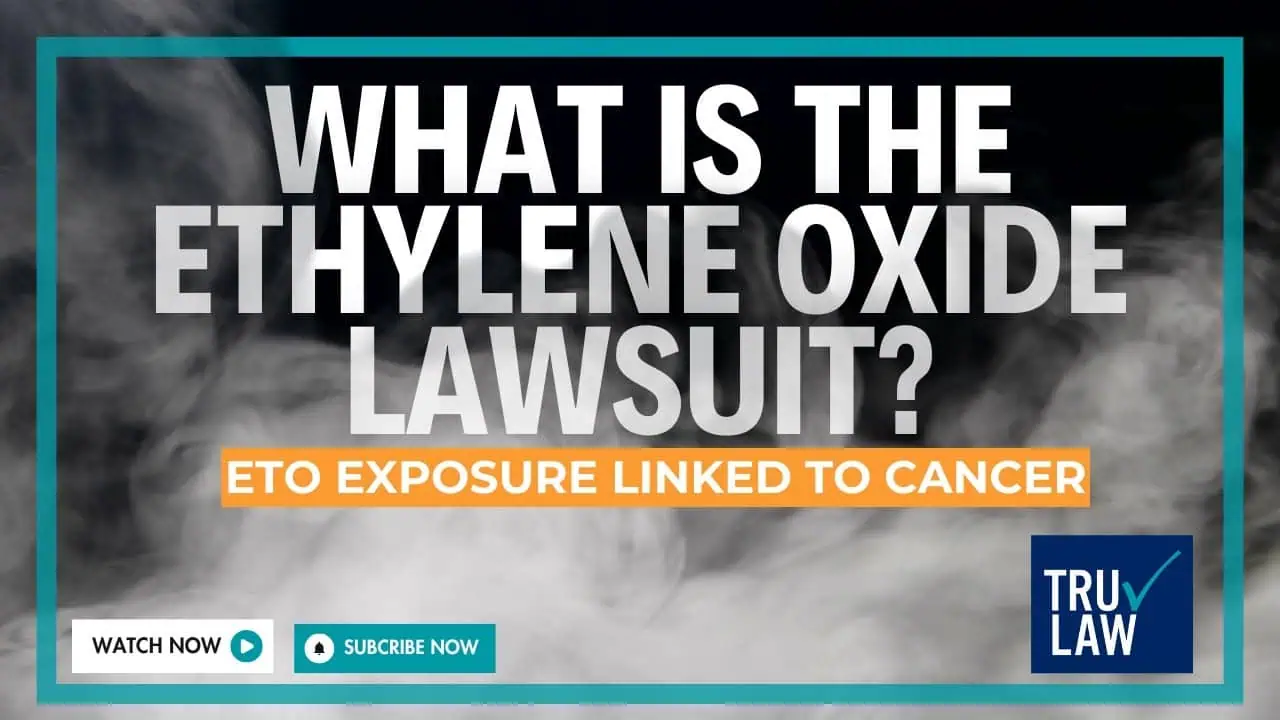
Do You Qualify for the Ethylene Oxide Exposure Lawsuit?
Across America, medical sterilization facilities, including Sterigenics facilities and other commercial sterilizers, use ethylene oxide to sterilize medical equipment – releasing this dangerous carcinogen into surrounding neighborhoods.
After extensive review through the ethylene oxide registration review process, the Environmental Protection Agency (EPA) has classified ethylene oxide (a colorless gas that can be harmful even at levels below detection thresholds) as a carcinogenic chemical in the Group 1 category – the highest risk level indicating proven cancer-causing properties in humans.
While valuable for sterilizing heat-sensitive medical tools and select food items as an EPA registered antimicrobial pesticide – EtO is classified as a hazardous air pollutant that creates substantial health risks when people breathe it regularly.
Health experts have connected EtO inhalation to multiple cancer types, including (but not limited to):
- Breast cancer
- Leukemia (ALL, AML, CLL, and Hairy Cell Leukemia)
- Hodgkin lymphoma and various types of Non-Hodgkin lymphoma
- Multiple myeloma
People living in proximity to facilities using this chemical face excess cancer risk, particularly when proper emission controls aren’t in place.
Scientific studies demonstrate that ongoing exposure can damage DNA, harm cells, and promote tumor growth.
Tragically, many victims experienced chronic exposure to this toxic chemical for years without any knowledge of its dangers.
Current Ethylene Oxide lawsuits aim to hold Sterigenics facilities and similar companies responsible for failing to protect communities from these dangerous emissions while seeking fair compensation for those now facing life-changing health battles.
Attorney Jessica Paluch-Hoerman brings specialized knowledge in chemical exposure cases to TruLaw’s ethylene oxide litigation team, including matters related to comprehensive risk assessment findings, regulatory agencies and compliance.
TruLaw collaborates with top ethylene oxide litigation specialists nationwide for both community exposure and occupational exposure cases – giving clients access to the most effective legal strategies and resources.
If you or someone you love received a cancer diagnosis or developed other serious health problems after living near a facility with known ethylene oxide emissions, you may be eligible to seek compensation.
Contact TruLaw using the chat on this page to receive an instant case evaluation and determine whether you qualify to join others in filing an Ethylene Oxide lawsuit today.
Table of Contents
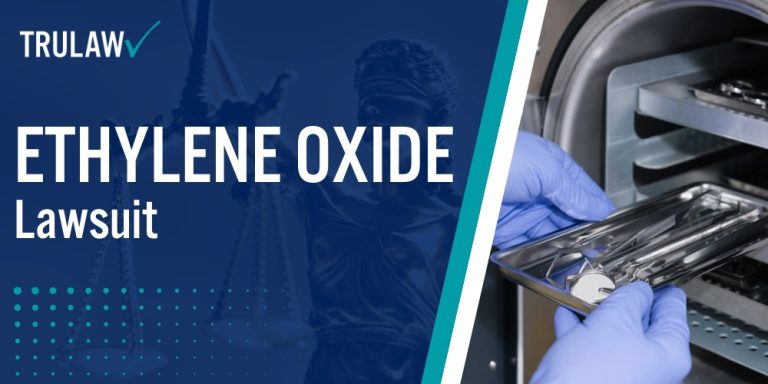
Ethylene Oxide Lawsuit Updates Timeline
New air testing in multiple U.S. communities reveals ethylene oxide (EtO) levels much higher than previously reported by the EPA, with some readings reaching hundreds of times above the agency’s cancer risk threshold.
The Spotlight on America team collaborated with the Southwest Research Institute and utilized a mobile air lab to perform real-time monitoring near sterilization facilities.
In one Illinois neighborhood, EtO levels hit 92,000 nanograms per cubic meter—more than 300 times the EPA’s concern threshold.
The findings further undermine the trustworthiness of government air modeling, a key issue in EtO exposure lawsuits.
Plaintiffs claim that long-term exposure to EtO from medical sterilization facilities caused cancer and other serious health issues.
The new data may reinforce claims that residents were unknowingly exposed to harmful levels of EtO due to underreported emissions and insufficient federal oversight.
The Biden administration is evaluating potential rollbacks to the HON (Hazardous Organic NESHAP) rule that could allow chemical plants—particularly those emitting ethylene oxide (EtO) and other hazardous pollutants—to qualify for exemptions from strict emissions limits.
The HON rule is designed to target major industrial polluters and reduce cancer risks for more than 10 million people, especially those living near petrochemical sites.
Under the proposed changes, companies could postpone installing pollution control technologies if doing so is considered technologically or financially impractical, subject to White House approval.
While no formal exemptions have been granted yet, environmental advocates warn that such loopholes could significantly erode protections for communities surrounding facilities with long records of noncompliance.
Ethylene oxide, a toxic chemical classified as a known carcinogen, has been strongly linked to blood and breast cancers. Communities near emitting facilities and workers in high-exposure settings face elevated risks.
According to a recent EPA analysis, some workers in medical sterilization plants may face cancer risks as high as 1 in 10 due to EtO exposure.
Public health experts and environmental groups argue that softening the HON rule would disproportionately harm vulnerable populations and could reverse recent progress in reducing toxic air pollution and cancer-related risks.
Delaware legislators have passed a new bill that significantly raises fines for environmental violations and allocates those funds to communities located within a two-mile radius of the pollution source.
Now awaiting the governor’s signature, the legislation expands the enforcement powers of the state’s Department of Natural Resources and Environmental Control (DNREC), including the ability to challenge Environmental Appeals Board rulings involving repeat offenders.
The bill raises maximum daily penalties by as much as $30,000 for certain infractions—some of which haven’t been updated in over five decades—and establishes a new fund aimed specifically at assisting communities most directly affected by pollution, rather than distributing resources on a statewide basis.
Residents living near long-criticized sites like Croda Inc.’s Atlas Point facility and the Delaware City Refinery welcomed the legislation, calling it a necessary step toward greater accountability and health safeguards.
Environmental groups have long contended that previous fine structures were too minimal to discourage persistent violators, often forcing DNREC to emphasize compliance over enforcement due to the high cost of appeals.
The Delaware State Chamber of Commerce opposed the measure, citing concerns over increased liability exposure and insurance costs stemming from what they characterized as disproportionate penalty increases.
Ethylene oxide (EtO) is a toxic gas used in medical sterilization and chemical manufacturing, and exposure to it has been linked to serious health conditions.
Workers who regularly encounter EtO—especially in sterilization facilities, hospitals, and nearby businesses—face increased risks of developing lymphoma, leukemia, breast cancer, respiratory issues, and reproductive harm.
Exposure often occurs through inhalation or skin contact, particularly in workplaces with inadequate ventilation or safety protocols.
While workers’ compensation may be one avenue for relief, many affected individuals may also have grounds for filing toxic tort or product liability lawsuits against negligent employers or equipment manufacturers.
To support a legal claim, exposed workers should begin collecting:
- Detailed job descriptions and employment history
- Medical records and diagnostic reports
- Workplace exposure logs or monitoring results
- Testimonies from coworkers about unsafe conditions
Employers are obligated to monitor EtO levels, provide protective gear, and ensure proper safety training.
A failure to uphold these responsibilities may open the door to legal action.
Communities throughout North Carolina may be unknowingly exposed to dangerous levels of ethylene oxide (EtO), a toxic gas used to sterilize medical supplies.
A recent WRAL report identified five warehouses across the state storing EtO-sterilized products—one of which is located in Four Oaks, just 1,100 feet from nearby homes.
These warehouses, operated by companies such as Becton Dickinson, Owens & Minor, and Medline, remain largely unregulated despite EtO being classified as a known human carcinogen.
Long-term exposure to the gas has been linked to serious health risks, including breast cancer and non-Hodgkin lymphoma—even at very low concentrations.
While sterilization facilities are subject to federal EtO emission standards, off-site warehouses that store sterilized products are not currently held to the same regulatory oversight.
North Carolina does not monitor emissions from these storage sites, and the EPA has yet to propose rules to address this regulatory loophole.
Residents near the Four Oaks warehouse have voiced concerns about air quality and public health, urging officials to implement more robust monitoring and transparency.
Steris Corporation has agreed to pay up to $48.15 million to settle personal injury lawsuits tied to ethylene oxide (EtO) emissions from its former sterilization facility in Waukegan, Illinois.
The settlement, reached through Steris’s Isomedix subsidiary, is intended to resolve nearly all pending cases in Cook County Circuit Court involving claims of cancer and other serious health issues.
Plaintiffs allege that emissions from the facility, operated between 2005 and 2008, exposed surrounding communities to harmful levels of EtO—a carcinogenic gas used widely in medical sterilization.
Although Steris denies liability and maintains the emissions posed no safety risk, the company agreed to the payout to efficiently resolve litigation.
The deal, disclosed in a March 2025 securities filing, is still subject to court approval and requires a significant number of plaintiffs to opt in.
If these conditions are not met, Steris may withdraw from the agreement and proceed with defense in court.
The EPA continues to flag EtO sterilization plants as high-risk cancer sites, prompting tighter federal regulations and pressure to transition to safer alternatives.
A Georgia judge has declared a mistrial on the issue of punitive damages in a lawsuit involving C.R. Bard, following a recent $20 million compensatory award to plaintiff Gary Walker.
The decision to retry this portion of the case comes after a juror disclosed that they did not personally agree with the original decision but went along with the rest of the jury.
The retrial will focus solely on whether C.R. Bard should be held liable for punitive damages in connection with its sterilization facility in Covington, Georgia.
Walker, a longtime resident of the area and a former delivery driver for the plant, was diagnosed with non-Hodgkin’s lymphoma after years of exposure to ethylene oxide, a chemical commonly used in sterilization processes and known to carry significant health risks.
The jury had initially awarded $50 million in punitive damages, but that award was voided following the juror’s admission.
Judge Emily Brantley has confirmed that a new trial will be scheduled to decide if Bard’s conduct demonstrated intent or conscious indifference—standards that must be met under Georgia law to justify punitive damages.
Jurors, however, will not be informed of any statutory caps that may apply to such damages.
Walker’s case is one of many emerging from growing concerns over toxic emissions from medical sterilization facilities.
The Environmental Protection Agency responded to these concerns in March 2024 by issuing stricter safety regulations, including continuous emissions monitoring and enhanced controls for sterilization equipment.
While alternatives to ethylene oxide have been proposed, the gas remains widely used in the medical industry across the United States, keeping litigation and regulatory scrutiny at the forefront of public health discussions.
A Georgia jury awarded $20 million to Gary Walker, a retired truck driver who claimed exposure to ethylene oxide (EtO) from C.R. Bard’s Covington sterilization plant caused his lymphoma.
The jury found Bard liable for both negligence and nuisance, determining that a second trial phase is necessary to address punitive damages.
That next phase is scheduled to begin on Monday, May 19.
Walker, now in remission, lived roughly 1.5 miles from the Bard facility beginning in 1991 and regularly delivered to the site until his retirement in 1999.
He was diagnosed with lymphoma in 2017 at age 68 and received ten rounds of chemotherapy in addition to a stem-cell transplant.
His attorneys introduced internal documents and regulatory records showing Bard declined to adopt emissions controls for decades despite repeated warnings from both regulators and its ethylene oxide supplier, Union Carbide.
The jury reviewed a 1985 memo from Georgia environmental officials noting that Bard “does not want to control its emissions at this time.”
During closing arguments, plaintiff’s attorney Lindsay Forlines asserted that Bard had the tools to limit emissions but chose not to use them.
Defense counsel Eric Rumanek countered that Walker’s illness was unrelated, pointing out that no physician had directly linked his cancer to EtO exposure.
This case marks the first EtO exposure verdict in Georgia favoring a plaintiff, potentially opening the door to significant legal exposure for Bard.
Judge Emily Brantley will preside over the punitive damages retrial beginning May 19.
A Georgia jury began proceedings Tuesday in a case alleging that C.R. Bard’s Covington sterilization plant exposed a nearby resident to ethylene oxide (EtO) over several decades, leading to his cancer diagnosis.
The plaintiff, Gary Walker, a retired truck driver, claims he developed non-Hodgkin lymphoma due to years of residential and occupational exposure to the chemical.
According to his legal team, the facility released close to 10 million pounds of EtO between 1970 and 2017, operated without emissions controls until 1990, and ignored repeated warnings from both regulators and its EtO supplier, Union Carbide.
Jurors were shown a 1985 memo from Georgia environmental officials stating that Bard “does not want to control its emissions at this time.”
Bard denies any responsibility, asserting that Walker’s illness was caused by a random genetic mutation unrelated to EtO exposure.
The company maintains that it has complied with regulatory standards and adopted safety measures in line with evolving federal guidelines.
Defense attorneys also pointed to the critical role EtO plays in sterilizing more than half of all medical devices used in the United States, and emphasized Bard’s use of emissions monitoring and pollution controls.
This trial marks the first EtO exposure case in Georgia to be brought before a jury.
Similar lawsuits are underway in other states, including recent defense-favorable outcomes in Colorado and Pennsylvania.
Steris Corporation has agreed to a settlement of up to $48.15 million to resolve personal injury lawsuits tied to ethylene oxide (EtO) emissions from its former sterilization facility in Waukegan, Illinois.
The settlement, negotiated through Steris’ Isomedix subsidiary, is intended to resolve nearly all of the active cases filed in Cook County Circuit Court, which allege cancer and other serious health conditions linked to EtO exposure.
Disclosed in a March 2025 securities filing, the agreement follows increasing legal and regulatory attention to EtO, a gas classified as carcinogenic and widely used to sterilize medical devices in the United States.
Plaintiffs claim that emissions from the Waukegan plant posed a health threat to the surrounding community between 2005 and 2008, the years during which Steris operated the site.
Although Steris has not admitted any liability or acknowledged that the emissions posed a health risk, the company stated that the agreement is intended to resolve the litigation efficiently and avoid prolonged legal proceedings.
Steris announced it will record the settlement as a charge in its fiscal 2025 financials but will exclude it from adjusted earnings.
Earlier this year, the first EtO case against Steris concluded in a mistrial, leaving the door open for further litigation.
The proposed settlement is now subject to court approval and requires a significant majority of plaintiffs to agree to its terms; if that threshold is not reached, Isomedix retains the option to withdraw and resume its legal defense.
The Environmental Protection Agency has identified several EtO-emitting sterilization sites across the country as high cancer risk areas, prompting stricter emissions standards.
In response to regulatory pressure, sterilization companies and device manufacturers are exploring alternatives such as vaporized hydrogen peroxide to reduce dependence on EtO.
Steris continues to operate as one of the leading global providers of medical sterilization services through its Applied Sterilization Technologies division, which has since absorbed the Isomedix name.
Medical device manufacturer B. Braun has reached a confidential settlement resolving the majority of lawsuits filed by residents near its Lehigh County, Pennsylvania facility, who alleged harmful exposure to ethylene oxide (EtO), a gas associated with cancer and neurological disorders.
Dozens of individuals had brought legal claims asserting that emissions from the sterilization plant led to increased health risks, including diagnoses of breast cancer, lymphoma, and other serious conditions.
Although B. Braun continues to deny any liability, the company confirmed the settlement this week and stated it will still defend against the remaining unresolved cases.
Details of the agreement have not been made public.
In response to growing legal and public health concerns, B. Braun reported that it voluntarily installed a new emissions control system in 2020 that has reduced EtO emissions by more than 99.9%, exceeding current regulatory requirements.
This settlement comes amid heightened national focus on EtO emissions and their potential health impacts.
In March 2024, the Environmental Protection Agency implemented more stringent rules for commercial sterilization facilities, mandating real-time air monitoring and imposing limits on emissions during start-up and shutdown processes.
These rules apply to roughly 90 sterilization sites across the United States.
The legal actions against B. Braun are part of a broader trend of litigation aimed at companies in the medical sterilization sector.
In 2023, Sterigenics agreed to a $408 million settlement in cases involving EtO exposure in Illinois, Georgia, and Michigan, while Steris is currently facing hundreds of similar lawsuits nationwide.
Although ethylene oxide remains a cornerstone in sterilizing approximately half of all medical devices used in the U.S., mounting pressure from health advocates and legal developments is fueling demand for safer alternatives.
As litigation progresses and regulatory scrutiny intensifies, both manufacturers and policymakers may face increased urgency to transition toward less hazardous sterilization technologies.
Cosmed Group Inc., a sterilization company serving the medical and food industries, has filed for Chapter 11 bankruptcy protection in Houston, Texas, in the face of growing litigation over its use of ethylene oxide (EtO).
The filing comes after the company was named in more than 300 lawsuits, including two class actions, alleging that EtO emissions from its facilities caused cancer and other serious health issues in nearby communities.
Ethylene oxide is a chemical used in sterilizing medical devices and food products, and it is classified as a known human carcinogen.
At a court hearing, Cosmed’s attorney, David Eastlake, stated that the volume and scope of the litigation—spanning multiple jurisdictions and including both active and former facilities—posed a significant threat to the company’s continued operation.
Cosmed filed for bankruptcy alongside its affiliate, Spicey Partners Real Estate Holdings, with both entities reporting liabilities exceeding $100 million.
U.S. Bankruptcy Judge Christopher Lopez approved an emergency motion to allow the company to meet its $65,000 payroll for its 51 employees, while other funding and operational matters will be addressed in subsequent hearings.
This is not Cosmed’s first encounter with environmental compliance issues; in 2005, the company paid $1.5 million to settle a U.S. Environmental Protection Agency investigation into EtO emissions at multiple facilities across six states.
The bankruptcy filing follows a broader pattern of legal and regulatory challenges for sterilization firms, as public and governmental scrutiny of ethylene oxide intensifies.
At this stage, Cosmed has not indicated whether it plans to pursue a global settlement strategy through its bankruptcy proceedings.
Sterigenics, along with its parent company Sotera Health, has reached a $35 million settlement to resolve a set of lawsuits alleging that emissions from its medical sterilization facility in Cobb County, Georgia, caused cancer and other health complications in nearby residents.
The agreement represents a key development in the expanding litigation landscape surrounding ethylene oxide exposure across Georgia.
The lead plaintiff in the settled case was diagnosed with leukemia at age 20 after living for 13 years in proximity to the Sterigenics facility.
His lawsuit, filed in 2020, claimed that long-term inhalation of airborne ethylene oxide—a chemical classified as a known carcinogen—was the most likely cause of his illness.
Ethylene oxide is widely used in the sterilization of medical equipment due to its effectiveness at disrupting DNA, but those same properties have been linked to increased cancer risk, particularly leukemia and lymphoma, according to the CDC and National Institutes of Health.
The case was one of the earliest legal actions in Georgia focused on emissions from Sterigenics, and its progression has helped prompt broader legal and regulatory attention to similar facilities.
The plaintiff is now in remission and has recently earned his degree from the University of Utah.
Under the terms of the proposed settlement, the agreement is contingent on full participation from all plaintiffs involved in the case.
Sterigenics and Sotera have not admitted liability or fault but stated the settlement is intended to resolve the claims efficiently and avoid further litigation.
This resolution does not address all pending lawsuits, as the companies continue to face additional personal injury and property damage claims.
Further hearings, including those set for October 2024, will examine scientific evidence concerning general causation and the risks posed by EtO exposure.
The $35 million agreement may influence the direction of other EtO-related cases in Georgia and potentially nationwide, as plaintiffs and regulators alike continue to scrutinize emissions from sterilization facilities and their impact on public health.
The U.S. Environmental Protection Agency (EPA) has finalized a sweeping regulatory update aimed at curbing emissions of hazardous air pollutants from the Synthetic Organic Chemical Manufacturing Industry (SOCMI) as well as polymer and resin production facilities.
This final rule specifically targets reductions in emissions of ethylene oxide (EtO) and chloroprene, both of which are classified as known human carcinogens.
- Emission Reductions: The EPA anticipates that the rule will result in a reduction of approximately 54 tons of ethylene oxide and 14 tons of chloroprene emissions each year, cutting emissions from regulated sources by about 80 percent.
- Health Impact: The EPA projects that these reductions will lead to a 96 percent decrease in cancer risks associated with toxic air exposure for communities located near the impacted industrial sites.
- Broader Environmental Gains: In addition to lowering toxic emissions, the rule is expected to reduce the release of volatile organic compounds (VOCs)—which contribute to smog formation—by more than 23,000 tons annually.
- Monitoring and Transparency: A major component of the rule includes mandatory fenceline air monitoring for chemicals such as EtO and chloroprene, with results made publicly available to enhance community awareness and environmental oversight.
This regulatory action reflects the EPA’s ongoing commitment to addressing the health risks posed by toxic air pollutants and to increasing transparency for populations living in proximity to chemical manufacturing operations.
The U.S. Environmental Protection Agency (EPA) is finalizing a long-awaited overhaul of its safety regulations for ethylene oxide (EtO), a toxic chemical widely used in the sterilization of medical devices and long linked to increased cancer risks.
The final rule—set to be issued by the March 1 deadline imposed by federal court—marks the EPA’s most significant update in over a decade concerning EtO emissions and occupational exposure standards.
Public Health Risks Prompt Regulatory Action
The new regulations follow years of growing concern fueled by a 2016 EPA risk assessment that identified EtO as substantially more carcinogenic than previously recognized.
EtO is already designated a human carcinogen by both the Centers for Disease Control and Prevention (CDC) and the National Institutes of Health (NIH), with established links to breast cancer, non-Hodgkin lymphoma, leukemia, and other serious conditions.
Particularly vulnerable populations include children and residents living near sterilization facilities—many of whom were unknowingly exposed to harmful concentrations of the gas for years.
Protests and litigation have emerged in communities from Laredo, Texas to Covington, Georgia, and the Chicago suburbs, where residents have demanded accountability and stronger protections after revelations of long-term exposure.
Recent legal outcomes include a $35 million settlement in Georgia involving Sterigenics and its parent company Sotera Health, and a $363 million jury verdict in Illinois awarded to a breast cancer survivor who lived near a sterilization facility.
Key Components of the New Rule
The EPA’s finalized rule is expected to include:
- More stringent emission limits for commercial sterilizers
- An 18-month timeline for facilities to achieve compliance
- Enhanced safety requirements for employees working directly with EtO
Despite these updates, environmental advocates have expressed concern that the rule does not go far enough.
Critics point to the lack of mandatory air monitoring around facilities and the absence of emissions controls for off-site warehouses where sterilized products may continue to release EtO.
Industry Response and FDA Warnings
While public health and environmental groups largely support the rule, industry representatives have voiced alarm over potential consequences.
The Advanced Medical Technology Association (AdvaMed) has warned that the new compliance standards could cost companies more than $500 million and disrupt sterilization operations critical to the medical supply chain.
The Food and Drug Administration (FDA) has also raised concerns, cautioning that overly burdensome regulations might limit the availability of essential medical devices.
Although alternative sterilization methods such as steam, radiation, and vaporized hydrogen peroxide exist, they are not universally suitable for complex or heat-sensitive products, making EtO a vital component of current sterilization protocols.
As the EPA implements this regulatory shift, the challenge will be balancing urgent public health needs with the operational realities of a medical system still heavily reliant on EtO.
Sterigenics and its parent company, Sotera Health, have agreed to pay $408 million to resolve claims from 879 individuals who allege they developed cancer and other illnesses due to ethylene oxide (EtO) emissions from the company’s former Willowbrook, Illinois facility.
The settlement resolves nearly all of the 882 pending lawsuits connected to the facility, which became the focus of litigation following a 2018 EPA report detecting dangerously high EtO levels in the surrounding community.
In 2019, Illinois officials ordered the permanent closure of the plant.
Since then, Willowbrook has been referred to as part of a broader network of “cancer alley” communities, where residents report elevated health risks tied to long-term EtO exposure.
EtO is used to sterilize approximately half of all medical devices in the United States, but it is also recognized as a human carcinogen with links to leukemia, lymphoma, breast cancer, and other diseases.
Children are considered especially vulnerable to its effects due to EtO’s ability to damage DNA.
The decision to settle follows a high-profile 2022 jury verdict that awarded $220 million to plaintiff Susan Kamuda, a breast cancer survivor who lived near the facility.
Additional penalties imposed on Sotera and Griffith Foods brought the total judgment in that case to $363 million.
That verdict likely played a significant role in prompting Sterigenics to settle the remaining claims rather than risk further multimillion-dollar trial outcomes.
Although the company continues to deny any wrongdoing and asserts that its operations were safe, it acknowledged the financial risks associated with prolonged litigation.
Based on the settlement total, the estimated average pre-tax payout per plaintiff is approximately $545,000.
Three plaintiffs have opted out of the agreement and will proceed with discovery and litigation.
This settlement does not conclude all of Sterigenics’ legal battles, as the company still faces EtO-related lawsuits in Georgia and New Mexico.
Meanwhile, the EPA has enacted new rules to sharply reduce EtO emissions, signaling that regulatory scrutiny and legal exposure for sterilization firms are likely to intensify.
The U.S. Environmental Protection Agency has initiated a national effort to educate the public about the health dangers of ethylene oxide (EtO), a gas commonly used to sterilize medical equipment.
The campaign features updated health risk assessments, online webinars, and in-person meetings for residents living near approximately 100 commercial sterilization sites.
Out of those, 23 facilities have been flagged as presenting heightened lifetime cancer risks due to prolonged exposure to EtO.
EPA Administrator Michael Regan stated that the agency is prioritizing transparency and increased community engagement, particularly in the most affected areas.
EtO exposure has been associated with several serious health conditions, including breast cancer and leukemia.
Although short-term exposure levels do not currently exceed federal safety thresholds, the EPA is most concerned about the risks of long-term, cumulative exposure, particularly for children and facility workers.
In response, the agency is gathering emissions data, reviewing Clean Air Act standards, and planning to introduce more rigorous pollution control measures for sterilization operations.
The EPA is also working closely with the Food and Drug Administration to ensure that tighter regulations do not disrupt the supply of critical medical devices.
In a major development aimed at enhancing transparency and environmental justice, the U.S. Environmental Protection Agency (EPA) announced an expansion of its Toxics Release Inventory (TRI) reporting requirements to include 29 commercial sterilization facilities previously exempt from such oversight.
These facilities utilize large quantities of ethylene oxide (EtO), a chemical classified as a known human carcinogen with documented links to breast cancer, leukemia, and other serious health conditions.
Under the new rule, facilities will also be required to report data related to ethylene glycol, a chemically related compound.
Prompted by years of concern from community advocates about undisclosed EtO emissions—especially in residential areas, near schools, and within historically underserved communities—the EPA is invoking its discretionary authority under the Emergency Planning and Community Right-to-Know Act (EPCRA) to require reporting from these high-use facilities.
The mandate applies to activities beginning January 2022, with data reporting starting in 2023.
The selected 29 facilities represent some of the highest EtO users in the contract sterilization industry and are expected to exceed the TRI threshold of 10,000 pounds annually.
Two additional facilities initially considered for inclusion were ultimately excluded—one has ceased sterilization operations, and the other uses EtO in minimal amounts that fall below reporting requirements.
This move marks a substantial step forward in the EPA’s efforts to provide communities with critical information on chemical exposures and to hold industrial emitters accountable.
What is Ethylene Oxide and How is it Used?
Ethylene oxide (EtO) is a colorless, flammable, typically odorous chemical widely used to sterilize medical devices and as a chemical intermediate in various manufacturing processes.
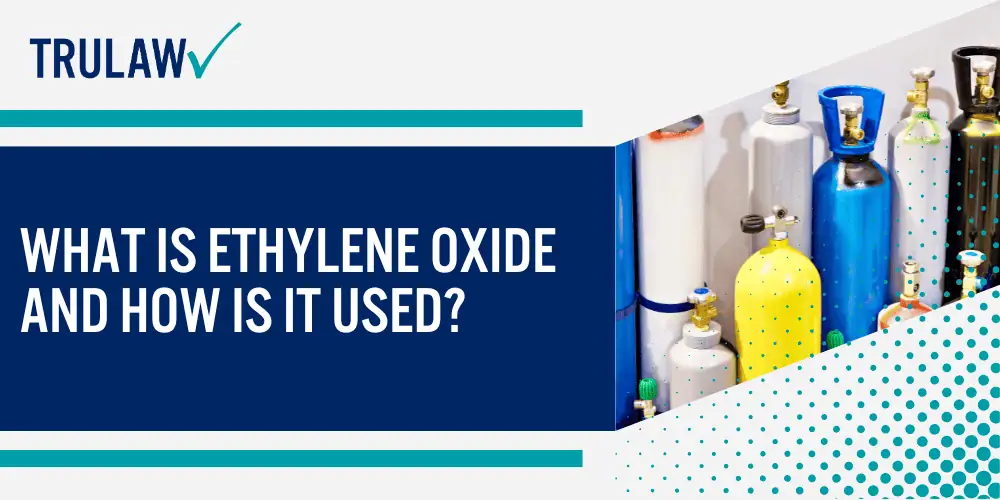
Its ability to penetrate materials makes it particularly valuable for sterilizing heat-sensitive medical devices, but this same property creates serious public health concerns.
Common Industrial Applications of Ethylene Oxide
EtO plays a key role in healthcare and manufacturing industries.
Approximately 50% of all medical devices in the United States (about 20 billion items annually) undergo EtO gas sterilization.
These include heat-sensitive items like catheters, surgical kits, pacemakers, and ventilators where other sterilization methods could damage the materials.
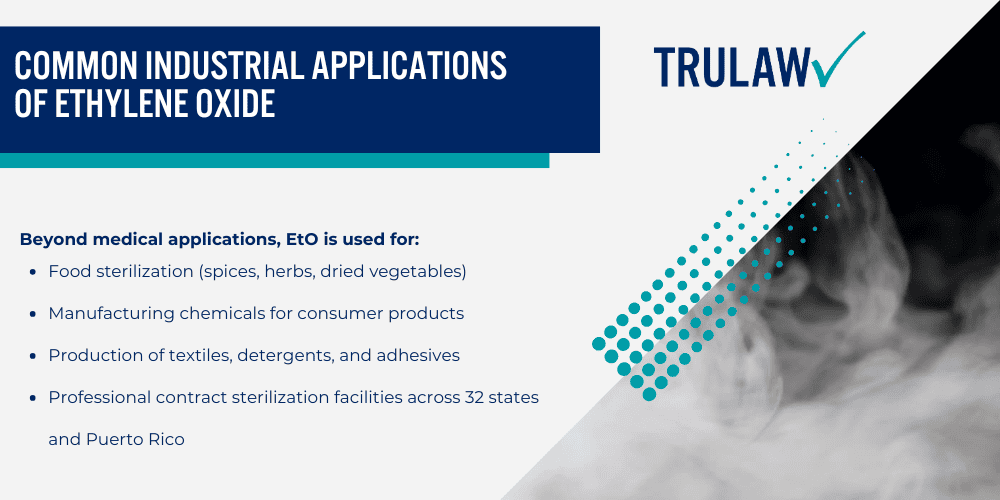
Beyond medical applications, EtO is used for:
- Food sterilization (spices, herbs, dried vegetables)
- Manufacturing chemicals for consumer products
- Production of textiles, detergents, and adhesives
- Professional contract sterilization facilities across 32 states and Puerto Rico
How Ethylene Oxide Emissions Occur
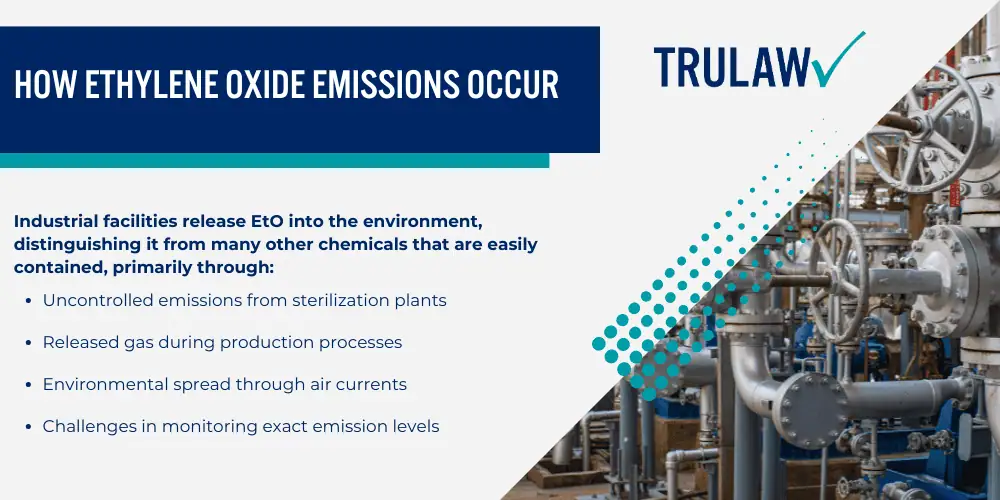
Industrial facilities release EtO into the environment, distinguishing it from many other chemicals that are easily contained, primarily through:
- Uncontrolled emissions from sterilization plants
- Released gas during production processes
- Environmental spread through air currents
- Challenges in monitoring exact emission levels
The Environmental Protection Agency (EPA) faces ongoing challenges regulating these emissions and requiring pollution control equipment due to the widespread use and economic importance of EtO in healthcare.
Communities at Highest Risk for Exposure
Recent EPA data has identified 23 facilities where EtO emissions contributed to elevated cancer risks for nearby residents with long-term exposure.
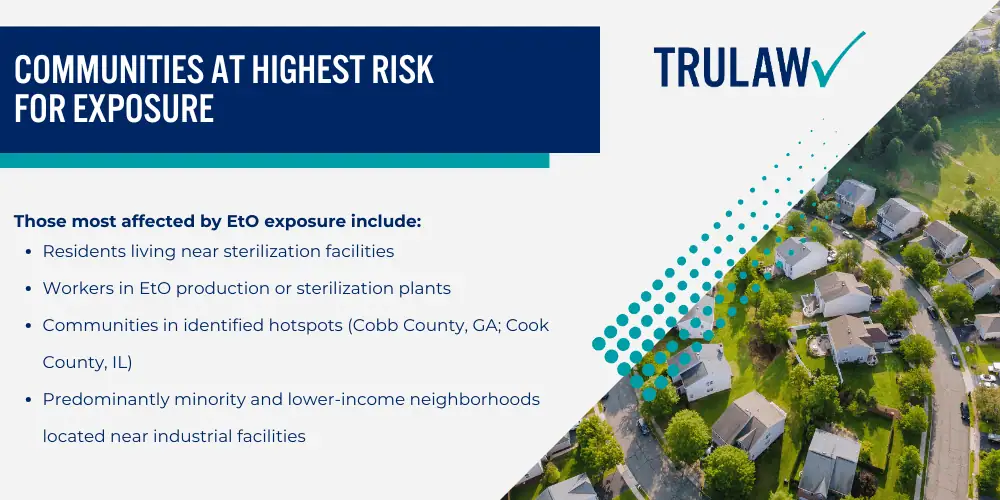
Those most affected by EtO exposure include:
- Residents living near sterilization facilities
- Workers in EtO production or sterilization plants
- Communities in identified hotspots (Cobb County, GA; Cook County, IL)
- Predominantly minority and lower-income neighborhoods located near industrial facilities
Health Risks and Medical Conditions Linked to Ethylene Oxide
The Environmental Protection Agency classifies ethylene oxide as a Group 1 human carcinogen, with EPA scientists confirming strong scientific evidence linking exposure to various forms of cancer.
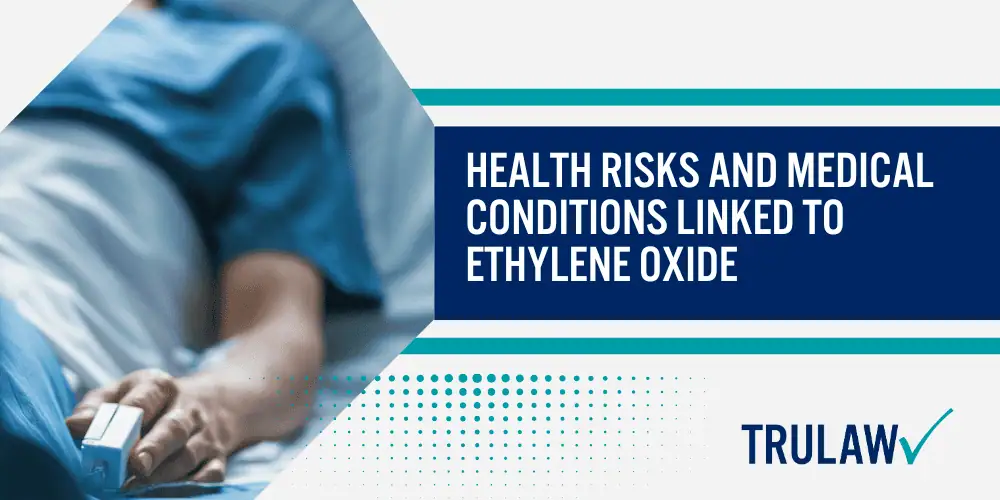
Many communities have experienced years of exposure without knowledge of the serious health hazards they faced.
Cancer Types Associated with EtO Exposure
Long-term exposure to ethylene oxide is linked to numerous cancer types, as documented in several major studies.
The NIOSH Study on Sterilizer Workers (2004) investigated over 18,000 workers at 14 commercial sterilization facilities – revealing positive exposure-response trends for lymphohematopoietic cancer mortality (particularly among males) and showed females who developed breast cancer at increased rates.
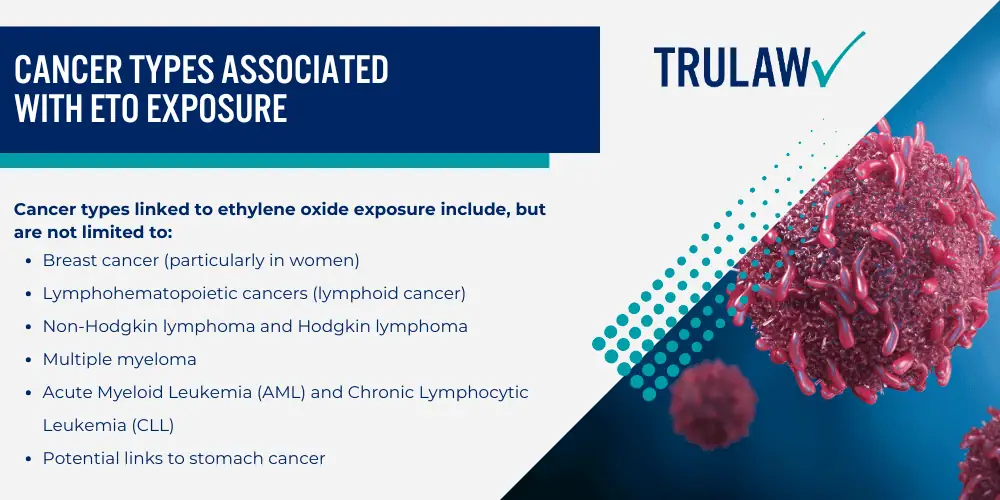
Cancer types linked to ethylene oxide exposure include, but are not limited to:
- Breast cancer (particularly in women)
- Lymphohematopoietic cancers (lymphoid cancer)
- Non-Hodgkin lymphoma and Hodgkin lymphoma
- Multiple myeloma
- Acute Myeloid Leukemia (AML) and Chronic Lymphocytic Leukemia (CLL)
- Potential links to stomach cancer
Non-Cancer Health Effects of Exposure
Beyond cancer risks, ethylene oxide exposure causes numerous non-cancer health effects, as documented in the OSHA Fact Sheet on EtO (2021).
Further, the ATSDR Clinician Brief on EtO (2021) indicates that even lower levels of exposure (0.08-0.17 ppm) can lead to detectable biomarkers of exposure, DNA damage, and effects on white blood cells and other hematological systems.
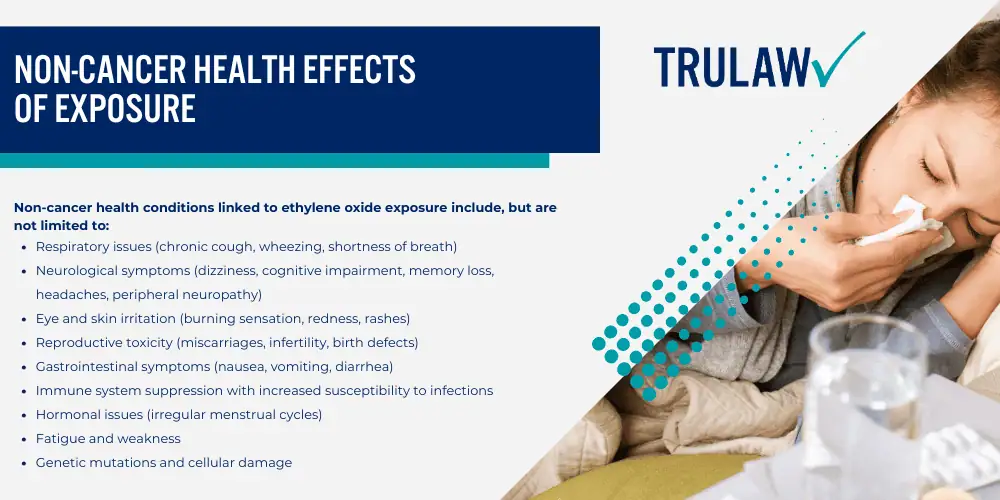
Non-cancer health conditions linked to ethylene oxide exposure include, but are not limited to:
- Respiratory issues (chronic cough, wheezing, shortness of breath)
- Neurological symptoms (dizziness, cognitive impairment, memory loss, headaches, peripheral neuropathy)
- Eye and skin irritation (burning sensation, redness, rashes)
- Reproductive toxicity (miscarriages, infertility, birth defects)
- Gastrointestinal symptoms (nausea, vomiting, diarrhea)
- Immune system suppression with increased susceptibility to infections
- Hormonal issues (irregular menstrual cycles)
- Fatigue and weakness
- Genetic mutations and cellular damage
Scientific Studies Confirming Health Risks
The EPA has calculated that ethylene oxide presents one of the highest risks ever calculated under the Clean Air Act, with some workplace exposures creating up to a 1-in-10 lifetime cancer risk.
Multiple authoritative organizations have published research validating ethylene oxide dangers:
- The EPA Evaluation of Inhalation Carcinogenicity (2016) formally classified EtO as “carcinogenic to humans” and updated previous assessments with data for regulatory decisions to protect public health
- International Agency for Research on Cancer designates EtO as a Group 1 carcinogen
- EPA’s Health Effects Notebook for Hazardous Air Pollutants provides a thorough toxicological profile of EtO and its implications for public health
- National Toxicology Program confirms EtO causes genetic mutations and cellular damage
Major EtO Lawsuit Cases and Settlements
Several landmark lawsuits against ethylene oxide emitters have resulted in substantial compensation for victims.

These cases have established important precedents for holding companies like Sotera Health and others accountable for endangering public health.
Sterigenics Willowbrook Case
The most noteworthy EtO litigation to date involves the Sterigenics sterilization facility in Willowbrook, Illinois – which resulted in groundbreaking verdicts and settlements:
- In September 2022, a Cook County jury awarded breast cancer survivor Sue Kamuda $363 million, including $38 million in compensatory damages and $325 million in punitive damages
- Her lawsuit alleged decades of toxic emissions from the facility led to her cancer diagnosis after living one-third of a mile from the plant
- In January 2023, Sterigenics agreed to a $408 million global settlement to resolve over 870 similar lawsuits from Illinois residents
- The EPA had previously found that people living near the facility had cancer rates up to 10 times the national average
- Following intense public pressure and intervention from the Illinois EPA, the Willowbrook facility closed permanently in 2019
Prominent EtO Litigation in Other States
Ethylene oxide litigation has spread to multiple states with active cases proceeding against various sterilization companies:
- Georgia litigation targeting Sterigenics’ Cobb County facility resulted in a $35 million settlement in October 2023 for 79 plaintiffs, though approximately 400 claims remain pending, with many involving exposure to EtO
- Pennsylvania lawsuits against B.Braun Medical’s Allentown facility claim emissions documented in the toxic release inventory caused cancer in nearby communities, with dozens of cases filed by affected residents
- In February 2025, B.Braun announced it had reached confidential settlements in “the majority” of the ethylene oxide claims against it
- Ongoing investigations and testing at additional facilities nationwide continue to reveal potential exposure risks in more communities
Ongoing Ethylene Oxide Exposure Investigations
TruLaw is actively investigating ethylene oxide exposure claims involving medical device manufacturers across the United States.
Facilities Under Investigation
Facilities currently under investigation include, but are not limited to:
- Sterigenics Sterilization Plant – Atlanta, Georgia
- Sterilization Services of Georgia – Atlanta, Georgia
- Kendall Patient Recovery U.S. (KPR) – Augusta, GA
- Becton Dickinson and Company (BD) – Covington, GA
- Becton Dickinson and Company (BD) – Madison, GA
Additional States with EtO Claims Being Investigated by TruLaw
Additional states we are currently investigating EtO expsosure claims for include, but are not limited to:
- Colorado
- Florida
- Massachusetts
- Maryland
- Missouri
- Nebraska
- New Jersey
- Oklahoma
- Pennsylvania
- Puerto Rico
- Tennessee
- Texas
- Utah
- Virginia
Determining Your Eligibility for an Ethylene Oxide Lawsuit
Individuals who lived or worked near facilities emitting ethylene oxide and later developed cancer or other serious health conditions may qualify to file a lawsuit.
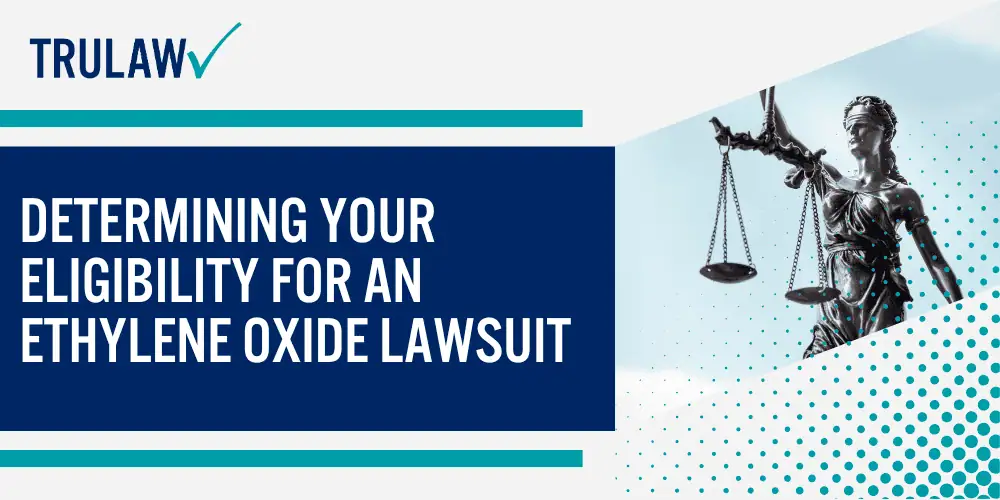
Understanding the eligibility requirements and evidence needed is an important first step in seeking justice.
Exposure Requirements for Legal Claims
To establish eligibility in an ethylene oxide lawsuit, you must demonstrate that you were exposed to the toxic gas in a manner that could lead to health issues:
- Geographic proximity to known EtO-emitting facilities (typically within 1-5 miles)
- Duration of exposure (generally at least one year of living or working near a facility, but this can differ on a case by case basis)
- Documentation of your residence or employment history in the affected area
- Evidence of the facility’s emission levels during your time of exposure
The EPA has identified approximately 100 commercial sterilization facilities across the United States that may have exposed nearby communities to harmful levels of ethylene oxide.
If you lived, worked, or spent significant time near one of these facilities, you should contact TruLaw for a free case evaluation to determine your eligibility.
Medical Diagnosis Criteria
A documented medical diagnosis is vital to establish the connection between EtO exposure and your health condition.
According to the National Institute for Occupational Safety and Health, qualifying health conditions may include, but are not limited to:
- Breast cancer
- Myeloma and Multiple Myeloma
- Hodgkin Lymphoma
- Non-Hodgkin Lymphoma
- Acute Lymphoblastic Leukemia (ALL)
- Acute Myeloid Leukemia (AML)
- Chronic Lymphocytic Leukemia (CLL)
- Hairy Cell Leukemia
- Potentially other various types of Leukemia
Courts examine both medical documentation and geographic data when determining lawsuit eligibility.
Your medical records will play a key role in establishing the link between your exposure and resulting health issues.
Statute of Limitations Concerns
Time restrictions for filing an ethylene oxide lawsuit vary by state and may be affected by when you discovered the connection between your illness and EtO exposure:
- Standard personal injury statutes range from 1-6 years depending on your state
- The “discovery rule” may extend the filing deadline, measured from when you reasonably discovered the cause of your illness
- Some states have special provisions for toxic exposure cases
- The clock may begin ticking from diagnosis date, date you learned about the facility’s emissions, or EPA announcements about local cancer risks
Because these timeframes can be difficult to calculate and vary significantly from case to case, it’s important to consult with TruLaw promptly if you believe you may qualify for an Ethylene Oxide exposure lawsuit claim.
Our team can evaluate the details of your situation and better help you understand how the statute of limitations may impact your case.
Compensation Available in Ethylene Oxide Exposure Cases
Victims of ethylene oxide exposure may be eligible for substantial compensation covering both economic and non-economic damages.
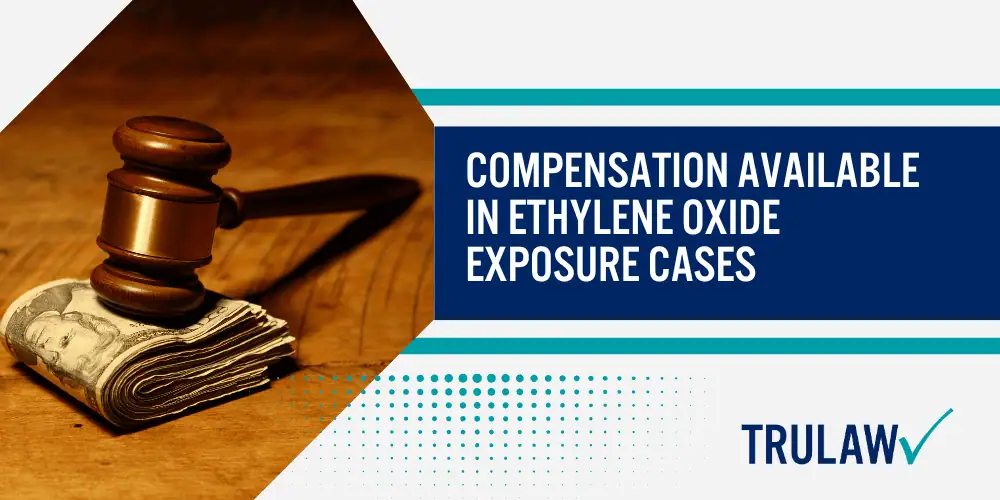
The specific amount varies based on individual circumstances, severity of illness, and evidence of corporate negligence.
Types of Damages Recoverable Through Ethylene Oxide Litigation
Recent settlements like the $408 million Sterigenics agreement in Illinois demonstrate that juries and courts recognize the serious impact of EtO exposure on victims’ lives.
If your ethylene oxide exposure case is successful, you may receive compensation for various types of damages – these include, but are not limited to:
- Pain and suffering damages for physical and emotional distress from both community and workers exposed to ethylene oxide
- Diminished quality of life and disability
- Additional damages outlined below
Medical expenses:
- Past and current treatment costs
- Future anticipated medical care
- Medications and specialized therapies
- Regular monitoring and follow-up visits
Lost income and economic losses:
- Wages lost during illness and treatment
- Reduced earning capacity
- Benefits and retirement contributions
- Career advancement opportunities lost
In wrongful death cases, compensation for:
- Funeral and burial expenses
- Loss of financial support
- Loss of companionship and guidance
Factors Affecting Compensation Amounts
Several key factors are used to determine the amount of compensation you may receive in an ethylene oxide case.
These factors may include, but are not limited to:
- Severity and type of illness (advanced cancers typically receive higher awards)
- Duration and intensity of exposure to ethylene oxide
- Quality of evidence linking exposure to your specific health condition
- Age at diagnosis and life expectancy impact
- Extent of corporate knowledge about risks and failure to warn
- Whether the company violated regulatory standards
- Economic impacts specific to your situation (high medical costs, inability to work)
- State laws that may cap certain damages in personal injury cases
- Strength of expert testimony connecting your illness to EtO exposure
In cases showing willful misconduct, punitive damages may be awarded on top of compensatory damages (as seen in the $325 million punitive damage award in Sue Kamuda’s case against Sterigenics).
Building a Strong Ethylene Oxide Lawsuit Case
Successful ethylene oxide litigation requires comprehensive evidence collection and expert testimony linking exposure to health outcomes.
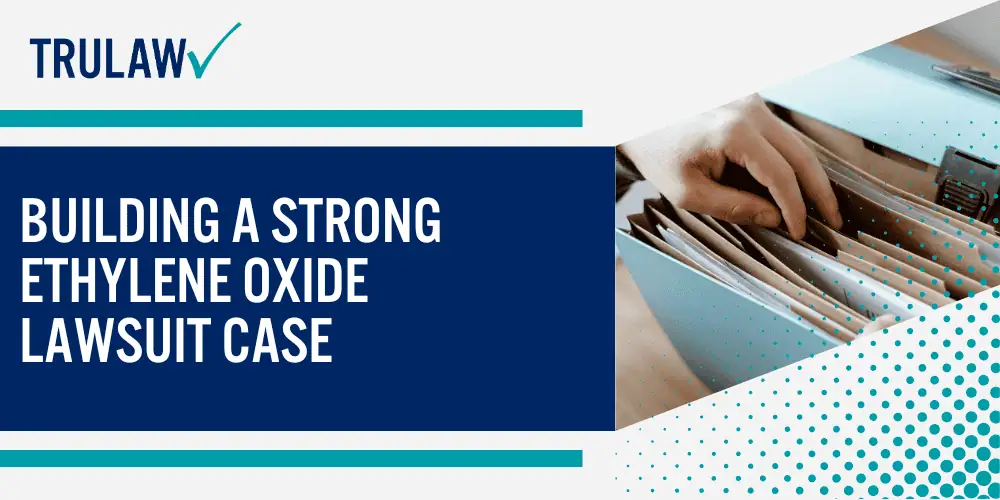
Working with experienced attorneys who understand the scientific and legal aspects of these cases is paramount.
Medical Evidence Requirements
Medical documentation forms the backbone of any ethylene oxide lawsuit, establishing the link between exposure and your health condition.
Medical evidence may include, but is not limited to:
- Complete medical records showing:
- Initial diagnosis documents from your healthcare provider
- Detailed treatment history with dates and procedures
- Ongoing care plans and medication regimens
- Medical imaging results related to your condition
- Pathology reports confirming your specific type of cancer
- Laboratory test results supporting your diagnosis
- Statements from treating physicians about potential environmental causes
- Timeline correlating your period of exposure with disease development
- Family medical history showing no genetic predisposition to your condition
Medical evidence must conclusively establish that you have a qualifying health condition linked to ethylene oxide exposure.
Your attorney will work with medical professionals to analyze these records and build a clear connection between your diagnosis and EtO exposure.
Environmental Testing and Exposure Documentation
Proving your exposure to ethylene oxide requires substantial environmental evidence:
- Air quality reports from areas surrounding EtO facilities
- EPA efforts to measure EtO emissions and monitoring data showing elevated levels in your community
- Geographic mapping showing your proximity to emission sources
- Duration of residence or employment in the affected area
- Facility emission records obtained through discovery or FOIA requests
- Weather pattern data showing how emissions may have traveled
- Historical regulatory violation notices issued to the facility
- Property records verifying your residence timeframe in the affected area
- Employment records if your exposure occurred at work
- Testimonies from other community members about odors or health impacts
The EPA’s ethylene oxide draft risk assessment provides important data on facilities with cancer risks exceeding acceptable limits.
Your attorney will use this information to establish that you lived or worked in an area with known elevated risk.
Working with Expert Witnesses
Expert witnesses play a vital role in ethylene oxide cases, providing specialized knowledge that helps establish causation and liability:
- Toxicologists who can explain how EtO affects human health at various exposure levels
- Epidemiologists to analyze cancer clusters and statistical evidence
- Environmental engineers familiar with emission control technologies
- Industrial hygienists who can assess workplace exposure scenarios
- Medical specialists in oncology or hematology to explain how EtO causes specific cancers
- Regulatory experts who understand EPA standards and compliance issues
- Air modeling specialists to track how emissions spread through communities
- Economic experts to calculate lifetime costs of your illness
Expert testimony bridges the gap between scientific evidence and legal requirements.
At TruLaw, we work with leading medical and environmental experts who understand ethylene oxide’s dangers and can effectively communicate these risks to a jury.
The strongest cases combine compelling personal medical evidence with extensive environmental documentation and authoritative expert testimony.
Experienced attorneys will build your case methodically, focusing on establishing a clear link between your diagnosis and ethylene oxide exposure.
TruLaw: Accepting Clients with Ethylene Oxide Exposure Lawsuit Claims
Ethylene oxide lawsuit claims are being filed by individuals across the country who developed cancer and other serious health conditions after being exposed to industrial emissions of this toxic gas.
TruLaw is currently accepting clients with ethylene oxide exposure lawsuit claims.
A few reasons to choose TruLaw for your ethylene oxide exposure lawsuit include:
- If We Don’t Win, You Don’t Pay: The ethylene oxide exposure lawyers at TruLaw and our partner firms operate on a contingency fee basis, meaning we only get paid if you win.
- Expertise: We have decades of experience handling toxic exposure cases similar to the ethylene oxide exposure lawsuit.
- Successful Track Record: TruLaw and our partner law firms have helped our clients recover billions of dollars in compensation through verdicts and negotiated settlements.
If you or a loved one developed health problems after exposure to ethylene oxide emissions from nearby sterilization facilities (or other industrial facility), you may be eligible to seek compensation.
Contact TruLaw using the chat on this page to receive an instant case evaluation that can determine if you qualify for the Ethylene Oxide Lawsuit today.
Ethylene Oxide Lawsuit Frequently Asked Questions
-
Ethylene oxide lawsuits typically take between one and three years to resolve.
The timeline varies based on case specifics, court schedules, and whether the case settles or goes to trial.
Mass tort cases involving multiple plaintiffs may take longer due to coordination requirements.
Your attorney can provide a more accurate timeline based on your specific situation.
You can discuss the details of your case with an attorney at TruLaw by using the chat on this page for an instant case evaluation.
-
Most ethylene oxide cases settle before reaching trial.
Companies often prefer to avoid the uncertainty and publicity of trials – especially after significant verdicts like the $363 million Kamuda case.
However, each situation is unique, and some cases do proceed to trial.
TruLaw helps prepare every case as if it will go to trial, while remaining open to fair settlement opportunities.
-
Yes, immediate family members can file wrongful death claims if a loved one died from cancer linked to ethylene oxide exposure.
These claims may seek compensation for medical expenses, funeral costs, loss of financial support, and loss of companionship.
Different time limits apply to wrongful death cases, so contacting TruLaw soon after the passing is advised.
-
TruLaw handles ethylene oxide cases on a contingency fee basis, meaning you pay nothing upfront.
Attorney fees are only collected if your case succeeds, typically as a percentage of the recovery amount.
This arrangement allows everyone access to quality legal representation regardless of financial situation.
-
In March 2024, the EPA finalized tighter regulations for commercial sterilization facilities, requiring controls to reduce ethylene oxide emissions by at least 90%.
These new standards aim to lower cancer risks in communities near these facilities and provide better air quality monitoring.
Facilities must implement these changes within 18 months of the final rule’s publication.
Additionally, in January 2025, the EPA issued an Interim Registration Review Decision that progressively reduces worker exposure limits from 1 ppm to:
- 0.5 ppm (2028);
- 0.25 ppm (2030); and
- 0.1 ppm (2035).
This decision also implements new concentration limits for sterilization cycles, continuous monitoring requirements, and phased elimination of EtO for certain applications.

Managing Attorney & Owner
With over 25 years of legal experience, Jessica Paluch-Hoerman is an Illinois lawyer, a CPA, and a mother of three. She spent the first decade of her career working as an international tax attorney at Deloitte.
In 2009, Jessie co-founded her own law firm with her husband – which has scaled to over 30 employees since its conception.
In 2016, Jessie founded TruLaw, which allows her to collaborate with attorneys and legal experts across the United States on a daily basis. This hypervaluable network of experts is what enables her to share the most reliable, accurate, and up-to-date legal information with our readers!
Additional Ethylene Oxide Lawsuit resources on our website:
Here, at TruLaw, we’re committed to helping victims get the justice they deserve.
Alongside our partner law firms, we have successfully collected over $3 Billion in verdicts and settlements on behalf of injured individuals.
Would you like our help?
At TruLaw, we fiercely combat corporations that endanger individuals’ well-being. If you’ve suffered injuries and believe these well-funded entities should be held accountable, we’re here for you.
With TruLaw, you gain access to successful and seasoned lawyers who maximize your chances of success. Our lawyers invest in you—they do not receive a dime until your lawsuit reaches a successful resolution!
AFFF Lawsuit claims are being filed against manufacturers of aqueous film-forming foam (AFFF), commonly used in firefighting.
Claims allege that companies such as 3M, DuPont, and Tyco Fire Products failed to adequately warn users about the potential dangers of AFFF exposure — including increased risks of various cancers and diseases.
Depo Provera Lawsuit claims are being filed by individuals who allege they developed meningioma (a type of brain tumor) after receiving Depo-Provera birth control injections.
A 2024 study found that women using Depo-Provera for at least 1 year are five times more likely to develop meningioma brain tumors compared to those not using the drug.
Suboxone Tooth Decay Lawsuit claims are being filed against Indivior, the manufacturer of Suboxone, a medication used to treat opioid addiction.
Claims allege that Indivior failed to adequately warn users about the potential dangers of severe tooth decay and dental injuries associated with Suboxone’s sublingual film version.
Social Media Harm Lawsuits are being filed against social media companies for allegedly causing mental health issues in children and teens.
Claims allege that companies like Meta, Google, ByteDance, and Snap designed addictive platforms that led to anxiety, depression, and other mental health issues without adequately warning users or parents.
Transvaginal Mesh Lawsuits are being filed against manufacturers of transvaginal mesh products used to treat pelvic organ prolapse (POP) and stress urinary incontinence (SUI).
Claims allege that companies like Ethicon, C.R. Bard, and Boston Scientific failed to adequately warn about potential dangers — including erosion, pain, and infection.
Bair Hugger Warming Blanket Lawsuits involve claims against 3M — alleging their surgical warming blankets caused severe infections and complications (particularly in hip and knee replacement surgeries).
Plaintiffs claim 3M failed to warn about potential risks — despite knowing about increased risk of deep joint infections since 2011.
Baby Formula NEC Lawsuit claims are being filed against manufacturers of cow’s milk-based baby formula products.
Claims allege that companies like Abbott Laboratories (Similac) and Mead Johnson & Company (Enfamil) failed to warn about the increased risk of necrotizing enterocolitis (NEC) in premature infants.
Here, at TruLaw, we’re committed to helping victims get the justice they deserve.
Alongside our partner law firms, we have successfully collected over $3 Billion in verdicts and settlements on behalf of injured individuals.
Would you like our help?
